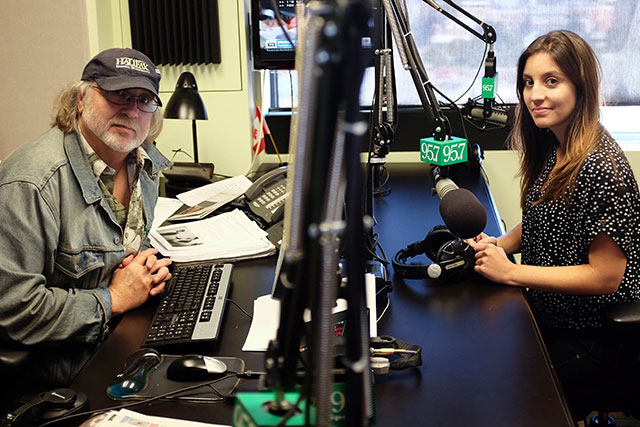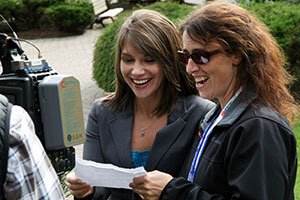Generation Y journalists: mobile, tech savvy, learning

caption
Rick Howe and Melissa Mancini entered the radio business 35 years apart, but find common ground and learn from each other while working on the Rick Howe Show at News 95.7 in Halifax.The future of journalism relies on Generation Y
The lights of the Maclean’s magazine office in Toronto have shut off for the night. Only one monitor remains. Tom Henheffer stares at his computer screen. He is editing videos for the newly launched Maclean’s TV web series.
After Henheffer completed his journalism degree at St. Thomas University in 2009, his paid internship at Maclean’s was extended after he was asked if he had web video production skills.
He said yes.
This answer had become a reflex he’d learned to trust when looking for work. He shares this instinct with other people in his struggling age group: the millennial generation.
“When I was starting out I was terrified to ever say no, and that’s the attitude everyone has,” says Henheffer.
A 2013 study by the Canadian Centre for Policy Alternatives reveals that in Toronto, Canada’s media capital, the gap between youth and adult employment is 21.8 per cent. It’s hard for young people to find jobs in all fields. After the 2008-09 economic crisis, which forced many U.S. news outlets to close, most believed jobs for young journalists would be few and far between.
Media north of the border weathered the recession better. No Canadian newspaper company fell below 10 per cent annual return on revenue during the economic collapse. Despite this resilience newsrooms were downsized, and a perfect storm of cost-cutting, rapid technology innovation, and audience demands changed the average reporter’s requirements. For news organizations, moving into the digital age meant hiring cheap, multi-skilled, temporary workers.
Enter the millennial journalist.
In 2011, Statistics Canada data showed that millennials, or “children of baby-boomers,” made up 27 per cent of Canada’s population. A 2008 Randstad Canada report showed that millennials made up 17 per cent of Canada’s labour force.
The reception from older generations hasn’t been warm, but criticizing the next wave of workers isn’t new.
In 1968 a Life cover story said 20-somethings would never understand making a living. In 1976 Tom Wolfe, writing for New York Magazine, referred to the ‘70s as “the ‘Me’ Decade.” Later the same year the New York Times referred to young people as “the Me generation.”
Though people studying millennials consider them to be a collaborative, determined, and multitasking group, a May 2013 Time article labeled millennials “Generation Me.”
It’s not like young workers have a choice between a wicked, secure, lifelong job with a pension and benefits and hefty paycheque and they turn this down for a crappy underpaid temp job.Karen Foster, sociology expert at Saint Mary’s University
Tulgan, based in New Haven, Conn., is the leading expert on young people in the workplace. Besides 18 books on generations and management, he has published articles in dozens of magazines and newspapers, including the New York Times, the Harvard Business Review and Fortune magazine. He says media jobs are a good fit for millennials.
They learned to think “inside the information environment,” says Tulgan. By growing up with computers in their homes, millennials became familiar with digital mediums. Now they are entering the workforce at a time when the production of media is budding. Tulgan says millennials have grown to have exceptional research and media production skills, making them ideal journalists.
“There is no such thing as being educated in this field and then you’re done,” he says. “The environment is constantly changing, staff are constantly training.” Tulgan believes the adaptive quality of millennials removes the disadvantage of being young and inexperienced.
That’s not to say there isn’t a demand for being highly skilled on arrival.
New technologies
Carleton University director of journalism Christopher Waddell says modern journalism is different. Editorial staff now shoulders much of the work that used to be done by “technological staff,” which “requires skill training that didn’t have to happen 15-20 years ago. Employers require newcomers to have those skills when they walk through the door.”
While millennials were born, so were new technologies. New methods of gathering and sharing content emerged as “new storytelling tools,” says Waddell. “Years ago you worked in one medium. This is no longer possible. Newspapers and TV stations are more like news networks, working across “multiple platforms.”
Henheffer experienced this multi-platform milieu when he helped launch web TV for Maclean’s.
“I was hired back on because I was a young person and they assumed I’d be able to do the job,” he says. “They were right, but still that’s how I got to stay there. Basically they could use me as a staff reporter, plus use me for video.”
Unlike the baby boom generation entering journalism in the ’70s, Henheffer and his cohorts need to be trained and prepared to use several storytelling tools.
Rick Howe has 42 years of experience in radio journalism. His first day on air was Dec. 28, 1972. His producer Melissa Mancini started 35 years later, on Oct. 19, 2007.
Howe says one difference between he and his young co-worker is their education.
“I came right out of high school and got a job,” he says, acknowledging that’s impossible today. “We require someone like Melissa to have some kind of journalism degree, at least background training.”
Mancini has two degrees, a bachelor of journalism from Carleton University and a master of journalism from the University of King’s College.
Harvey Schachter, a freelance columnist in Kingston, Ont., has a portfolio of commentary on Generation Y. Schachter started in print journalism around the same time Howe entered radio. Some of his peers spent their summers working in internships, much like today. “But there wasn’t that requirement whereby journalism schools need to teach you,” he says.
Approximately one in 10 of his peers were formally trained in journalism. Now the job requirements have changed, and the modern journalist has adapted.
Mancini says her role as the producer on the Rick Howe Show, aired on News 95.7, has changed even in the past few years.
“We’re constantly tweeting so that people will turn their radio on and listen,” she says.
Howe describes it as a “show within a show.” “It’s a show that I do on air, and then she has the show that’s talking to people on the phones and via twitter,” he says.
Besides being constantly connected to a rabid Twitter following, Mancini controls the soundboard, monitors Facebook for defamatory remarks, replies to emails, schedules speakers, and screens calls.
Howe says he’s been told repeatedly in the past decade there is a demand to do more, even though there is less staff and resources.
Taste of responsibility
When Henheffer was launching the web TV series for the biggest news magazine in Canada, he was given a $600 budget and only worked with one other person. But he converted the small amount of faith and investment into a successful product to complement the rest of the magazine.
Kayla Hounsell, weekend anchor for CTV Atlantic, recalls that in one of her first jobs she anchored the noon show and then reported for the six o’clock news.

caption
Kayla Hounsell, left, shares a laugh with CTV Atlantic promo producer Marnie Ells.“When I say that out loud it seems totally insane,” she says. In addition to her on air duties, she also wrote web editions of each story she covered.
Though it was challenging, Hounsell says the pace, multitasking requirements, and early taste of responsibility made her a better journalist.
That job, in Brandon, Man., was her second within six months of graduating from Carleton. In her final semester of school she was hired as a student reporter for CTV Ottawa. CTV was unable to give her a permanent position in Ottawa, but helped her land the job in Brandon. Hounsell relocated.
Eight months later she moved to Regina, Sask. Within a year she was offered a job as a reporter with CTV Atlantic, back in her native Maritimes.
“Four provinces in two years,” she says. “You need a willingness to move, do more for less, say yes and grab opportunities when they come up.”
Hounsell, Henheffer, and Mancini all studied journalism, entered a job market where they had temporary positions and all relocated frequently. Karen Foster, a postdoctoral expert of sociology at Saint Mary’s University, says this is a common path for millennials. “These are the jobs that are available, full-stop. It’s not like young workers have a choice between a wicked, secure, lifelong job with a pension and benefits and hefty paycheque and they turn this down for a crappy underpaid temp job. They have access to the latter and little hope of the former,” she says.
In Foster’s article Youth Employment and Un(der) Employment in Canada, she says the proportion of young employees in temporary jobs has doubled from 6.9 per cent in 1997 to 11.6 per cent in 2011.
Tulgan refers to millennial workers as “anywhere, anytime professionals,” more “amenable” than older counterparts.
After his time with Maclean’s, Henheffer was brought on to help pioneer and become the editor of the small business section at the Toronto Star. In his editorial role, he has worked with freelancers both young and old.
“I’ve found that—and it’s hard to generalize—but some of the older ones I work with are amazing and some are terribly inflexible,” he says. His millennial freelancers are more willing to accept edits, or go back to the drawing board.
When he needs a quick turnaround, he’ll call a millennial ready to hustle. When he wants worry-free copy and has the time to spare, an older, more seasoned writer is preferred.
He hopes the millennials will eventually produce clean copy quickly.
Harvey Schachter believes journalism thrives on the energy of young people. “I don’t want to put off the value of older people but in some ways the energy and feistiness has come from the younger people,” he says.
In the years to come, today’s young and feisty millennials will be a majority in newsrooms.
Rick Grant, a veteran newsman on Hounsell’s CTV Atlantic team, says once talented 20-year-olds mature and become editors and producers, “The quality of content will still be there, but how it’s delivered might be different.”
Carleton’s Waddell says it’s difficult to fit everything needed for a career in modern journalism into a curriculum, but there is still a strong focus on the traditional principles of reporting, including fact checking and finding strong sources.
One change likely to take place is an increase in effective multimedia stories. “As people develop these skills, journalists will decide what is the best medium to tell each part of the story,” says Waddell.
Some parts will be told with interactive infographics, others will have embedded audio or video.
Hounsell believes the product of the next generation of newsmakers will reflect a merging of new methods and old values. She says millennials learn their values from senior staff.
Grant says beyond tech skills, Hounsell and other millennials demonstrate fairness and a good sense of judgment. “They come in with good, strong values.”
Millennial journalists, Hounsell says, care about being first, but “it has to be right, has to be correct.”
It’s just likely to be correct across a few different platforms.
Editor's Note
News 95.7 in November 2013 switched its radio format to include more sports, and layoffs included Melissa Mancini.

